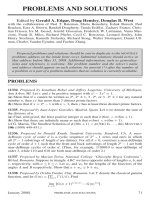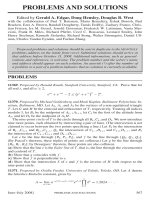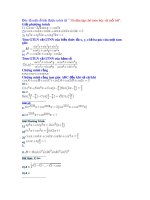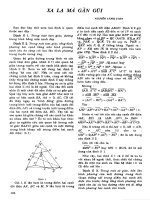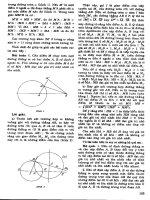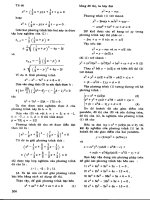Tạp chí toán học AMM tháng 2 năm 2008
Bạn đang xem bản rút gọn của tài liệu. Xem và tải ngay bản đầy đủ của tài liệu tại đây (92.29 KB, 8 trang )
PROBLEMS AND SOLUTIONS
Edited by Gerald A. Edgar, Doug Hensley, Douglas B. West
with the collaboration of Paul T. Bateman, Mario Benedicty, Itshak Borosh, Paul
Bracken, Ezra A. Brown, Randall Dougherty, Tam
´
as Erd
´
elyi, Zachary Franco, Chris-
tian Friesen, Ira M. Gessel, Jerrold Grossman, Frederick W. Luttmann, Vania Mas-
cioni, Frank B. Miles, Richard Pfiefer, Cecil C. Rousseau, Leonard Smiley, John
Henry Steelman, Kenneth Stolarsky, Richard Stong, Walter Stromquist, Daniel Ull-
man, Charles Vanden Eynden, and Fuzhen Zhang.
Proposed problems and solutions should be sent in duplicate to the MONTHLY
problems address on the inside front cover. Submitted solutions should arrive at
that address before June 30, 2008. Additional information, such as generaliza-
tions and references, is welcome. The problem number and the solver’s name
and address should appear on each solution. An asterisk (*) after the number of
a problem or a part of a problem indicates that no solution is currently available.
PROBLEMS
11341. Proposed by Cezar Lupu, University of Bucharest, Bucharest, Romania (stu-
dent), and Tudorel Lupu, Decebal High School, Constanza, Romania. Consider an
acute triangle with side-lengths a, b,andc, with inradius r and semiperimeter p.Show
that
(1 − cos A)(1 − cos B)(1 − cos C) ≥ cos A cos B cos C
2 −
3
√
3r
p
.
11342. Proposed by Luis H. Gallardo, University of Brest, Brest, France. Let p be a
prime and let F
q
be a finite field of characteristic p,whereq is a power of p.Letn be
a divisor of q − 1. With the natural mapping of Z onto F
p
and embedding of F
p
in F
q
,
show that (−1)
(n+2)(n−1)/2
n
n
is a square in F
q
.
11343. Proposed by David Beckwith, Sag Harbor, NY. Show that when n is a positive
integer,
k≥0
n
k
2k
k
=
k≥0
n
2k
2k
k
3
n−2k
.
11344. Proposed by Albert Stadler, Meilen, Switzerland. Let μ be the M
¨
obius μ func-
tion of number theory. Show that if n is a positive integer and n > 1, then
n
j =1
μ( j) =−
(n−1)/2
j =1
j
n/(2 j +1)
k=(n+1)/(2 j +3)
μ(k).
11345. Proposed by Roger Cuculi
`
ere, France. Find all nondecreasing functions f from
R to R such that f (x + f (y)) = f ( f (x)) + f (y) for all real x and y.
11346. Proposed by Christopher Hillar, Texas A&M University, College Station, TX,
and Lionel Levine, University of California, Berkeley, CA. Let n be an integer greater
166
c
THE MATHEMATICAL ASSOCIATION OF AMERICA [Monthly 115
than 1 and let S ={2, ,n}. For each nonempty subset A of S,letπ(A) =
j ∈A
j.
Prove that when k is a positive integer and k < n,
n
i=k
lcm({1, ,n/ i}) = gcd
(
{π(A) :|A|=n − k}
)
.
(In particular, setting k = 1 yields
n
i=1
lcm({1, ,n/ i}) = n!.)
11347. Proposed by Mih
´
aly Bencze, Brasov, Romania. Let A = (x + y)/2, G =
√
xy,
and
I =
1
e
x
x
y
y
1/(x −y)
.
Determine all ordered 4-tuples (α,β,γ,δ)of positive numbers with α>βand γ>δ
such that for all distinct positive x and y,
I >
α A + βG
α +β
>
A
γ
G
δ
1/(γ +δ)
>
√
AG.
SOLUTIONS
Orthogonal Sudoku Squares
11214 [2006, 268]. Proposed by Solomon W. Golomb, University of Southern Califor-
nia, Los Angeles, CA. A Sudoku solution is a 9 × 9 square array with integer entries
such that each of the nine possible entries occurs exactly once in each row, once in
each column, and once in each of the nine 3 × 3 subsquares that together tile the
main array. Is it possible for two Sudoku solutions to form a pair of orthogonal Latin
squares? (That is, can the 81 pairs of corresponding cells contain all 81 possible pairs
of entries?)
Solution by Kyle Calderhead, Illinois College, Jacksonville, IL. Yes. In fact, there is a
family of six pairwise orthogonal Latin Sudoku squares:
It comes from the usual construction of complete families of orthogonal Latin
squares, limited to the ones that also meet the Sudoku restrictions. The standard con-
struction permutes the rows of the addition table for the finite field F
9
, with the permu-
tations determined by the (nonzero) rows of the multiplication table. If we represent
F
9
as the set of congruence classes of polynomials over F
3
modulo a quadratic polyno-
mial such as x
2
+ 1 that is irreducible over F
3
, then the rows of the multiplication table
that result in Latin Sudoku squares are precisely those that correspond to nonconstant
polynomials. This produces the six Latin Sudoku squares shown below. More gener-
ally, for any prime p, the same technique will produce a family of p(p − 1) mutually
orthogonal p
2
× p
2
Latin Sudoku squares.
123456789
456789123
789123456
312645978
645978312
978312645
231564897
564897231
897231564
123456789
564897231
978312645
645978312
789123456
231564897
897231564
312645978
456789123
February 2008] PROBLEMS AND SOLUTIONS 167
123456789
645978312
897231564
978312645
231564897
456789123
564897231
789123456
312645978
123456789
789123456
456789123
231564897
897231564
564897231
312645978
978312645
645978312
123456789
897231564
645978312
564897231
312645978
789123456
978312645
456789123
231564897
123456789
978312645
564897231
897231564
456789123
312645978
645978312
231564897
789123456
Editorial comment. Lyle Ramshaw provided a proof that 6 is the maximum number of
pairwise orthogonal Latin squares of order 9. These results and others are dealt with
in “Sudoku, gerechte designs, resolutions, affine space, spreads, reguli, and Hamming
codes” by R. A. Bailey, Peter J. Cameron, and Robert Connelly, to appear shortly in
this M
ONTHLY.
Also solved by R. Bagby, J. Brawner, R. Chapman (U. K.), K. Dale (Norway), D. Degiorgi (Switzerland),
G. T. Fala, R. T. Guy, D. E. Knuth, O. P. Lossers (Netherlands), M. D. Meyerson & T. S. Michael, R. M. Ped-
ersen, L. Ramshaw, T. Q. Sibley, J. H. Steelman, R. Stong, H. Stubbs, R. Tauraso (Italy), L. Wenstrom, the
ABC Student Problem Solving Group, the BSI Problems Group (Germany), Szeged Problem Solving Group
“Fej
´
ental
´
altuka”(Hungary), the GCHQ Problem Solving Group (U. K.), the Northwestern University Math
Problem Solving Group, the VMI Problem Solving Group, and the proposer.
Maximum Velocity on a Car Trip
11215 [2006, 366]. Proposed by Shmuel Rosset, Tel Aviv University, Tel Aviv, Israel. A
car moves along the real line from x = 0att = 0tox = 1att = 1, with differentiable
position function x(t) and differentiable velocity function v(t) = x
(t). The car begins
and ends the trip at a standstill; that is, v = 0 at both the beginning and the end of the
trip. Let L be the maximum velocity attained during the trip. Prove that at some time
between the beginning and end of the trip, |v
| > L
2
/(L − 1).
Solution by Jos
´
e Heber Nieto, Universidad del Zulia, Moracaibo, Venezuela. Let M =
L
2
/(L − 1).If|v
|≤M for all t ∈[0, 1],thenv(t ) =
t
0
v
(u) du ≤ Mt and v(t) =
−
1
t
v
(u) du ≤ M(1 − t) for all t ∈[0, 1].SinceL = v(t
0
) for some t
0
∈[0, 1],we
have L ≤ Mt
0
and L ≤ M(1 − t
0
). Thus 1 −
1
L
≤ t
0
and t
0
≤
1
L
, and therefore L ≤ 2.
Now consider the function f defined by
f (t) =
⎧
⎪
⎨
⎪
⎩
Mt, if 0 ≤ t < 1 −
1
L
,
L, if 1 −
1
L
≤ t <
1
L
,
M(1 − t), if
1
L
≤ t ≤ 1.
168
c
THE MATHEMATICAL ASSOCIATION OF AMERICA [Monthly 115
Observe that
1
0
f (t) dt =
L
2
1 −
1
L
+ L
2
L
− 1
+
L
2
1 −
1
L
= 1.
We have v(t) ≤ f (t) for t ∈[0, 1]. Equality cannot hold everywhere, since f is not
differentiable at 1/L. Hence v(t
1
)< f (t
1
) at some t
1
∈[0, 1] and, by continuity,
v(t)< f (t) in some neighborhood of t
1
. Our assumption that |v
|≤M on [0, 1] thus
leads to this contradiction:
1 = x(1) − x(0) =
1
0
v(t) dt <
1
0
f (t) dt = 1.
Also solved by T. Achenbach, M. W. Botsko, D. Chakerian, P. Corn, J P. Grivaux (France), E. A. Herman, J. H.
Lindsey II, O. P. Lossers (Netherlands), T. L. McCoy (Taiwan), K. McInturff, M. D. Meyerson, R. E. Prather,
K. Schilling, J. Silver, J. G. Simmonds, R. Stong, J. B. Zacharias, L. Zhou, Szeged Problem Solving Group “Fe-
j
´
ental
´
altuka” (Hungary), GCHQ Problem Solving Group (U. K.), Houghton College Problem Solving Group,
Microsoft Research Problems Group, NSA Problems Group, and the proposer.
Goes Back to Boole
11234 [2006, 568]. Proposed by Jim Brennan and Richard Ehrenborg, University of
Kentucky, Lexington, KY. Let a
1
, ,a
n
and b
1
, ,b
n−1
be real numbers, with a
1
<
b
1
< a
2
<a
n−1
< b
n−1
< a
n
.Leth be an integrable function from R to R.Show
that
∞
−∞
h
(x − a
1
) ···(x − a
n
)
(x − b
1
) ···(x − b
n−1
)
dx =
∞
−∞
h(x) dx.
Solution by Eugene A. Herman, Grinnell College, Grinnell, IA. Let
f (x) =
(x − a
1
) ···(x − a
n
)
(x − b
1
) ···(x − b
n−1
)
.
On each of the open intervals
(−∞, b
1
), (b
1
, b
2
), ···,(b
n−1
, ∞) (1)
the function f is continuous and has limits −∞ and ∞ at the left and right endpoints,
repectively. Thus the range of f on each of these intervals is (−∞, ∞). Hence, for
every real number y, the equation y = f (x) has a solution in each of these n intervals.
In fact, there is exactly one solution in each interval, since on these intervals, f (x) −
y = 0 if and only if
(x − a
1
) ···(x − a
n
) − y (x − b
1
) ···(x − b
n−1
) = 0, (2)
which is a polynomial equation in x of degree n. Therefore, on each of these n inter-
vals, the function f is invertible. We denote the inverse of f on the ith interval by
g
i
. In particular, for any y ∈ R, the numbers g
1
(y), ···, g
n
(y) are the solutions of the
polynomial equation (2). Consequently, the sum of these solutions is the negative of
the coefficient of x
n−1
in (2); that is,
m
i=1
g
i
(y) = y +
n
i=1
a
i
. (3)
February 2008]
PROBLEMS AND SOLUTIONS 169
We transform the integral
∞
−∞
h( f (x)) dx by making the substitution y = f (x) in
each of the n intervals (1); that is, in the i th interval, we have x = g
i
(y) and hence
dx = g
i
(y) dy. Therefore
∞
−∞
h( f (x)) dx =
b
1
−∞
h( f (x)) dx +
b
2
b
1
h( f (x)) dx +···+
∞
b
n−1
h( f (x)) dx
=
n
i=1
∞
−∞
h(y)g
i
(y) dy =
∞
−∞
h(y)
n
i=1
g
i
(y) dy =
∞
−∞
h(y) dy.
The last step follows from equation (3).
Editorial comment. Six solvers noted that this result is a consequence of the following
theorem (∗): If h(x) is integrable and g(x) = x −
m
i=1
c
i
/(x − b
i
) where all the c
i
are positive, then
∞
−∞
h(g(x)) dx =
∞
−∞
h(x) dx. This reduction is obtained by writ-
ing
(x −a
1
)···(x −a
n
)
(x −b
1
)···(x −b
n−1
)
in its partial fraction form g(x) = x + C −
m
i=1
c
i
/(x − b
i
),using
the given conditions to show that all the c
i
are positive, then appealing to theorem (∗)
and to the translation invariance of Lebesgue measure. References provided for theo-
rem (∗) were: (1) G. Boole, “On a general theorem of definite integration,” Cambridge
& Dublin Mathematical Journal, 1849; G. Boole, “On the comparison of transcen-
dents ” Philos. Trans. Roy. Soc., London 147 (1857) 745–803 (the proof perhaps
not meeting modern standards of rigor); (2) M. L. Glasser, “A remarkable property of
definite integrals,” Math. Comput. 40 (1983) 561–563; (3) G. P
´
olya & G. Szeg
˝
o, Prob-
lems and Theorems in Analysis, vol. 1 (Springer, New York, 1972), Problem II-12.
Also solved by K. F. Andersen (Canada), R. R. Avidon, R. Bagby, R. Chapman (U. K.), N. Cohen (Brazil), P. P.
Dalyay (Hungary), B. Dunn, P. J. Fitzsimmons, M. L. Glasser, J P. Grivaux (France), J. Groah, J. A. Grzesik,
F. Holland (Ireland), G. Keselman, J. H. Lindsey II, O. P. Lossers (Netherlands), D. Lubell, M. Mabuchi
(Japan), J. Mack, W. Matysiak (Poland), T. L. McCoy (Taiwan), A. Nijenhuis, P. Perfetti (Italy), A. Quas
(Canada), K. Schilling N. C. Singer, A. Stadler (Switzerland), R. Stong, C. T. Stretch (Ireland), R. Tauraso
(Italy), S. Vagi, E. I. Verriest, L. Zhou, BSI Problems Group (Germany), GCHQ Problem Solving Group
(U. K.), Microsoft Research Problems Group, NSA Problems Group, and the proposers.
Coloring the Plane
11236 [2006, 655]. Proposed by Jim Owings, Riderwood, MD. Given a positive integer
n and a positive real number x, consider the proposition P(x, n): If we color each
point in the Euclidean plane with one of n colors, then there exist two points of the
same color that are either distance 1 or distance x apart.
(a) Prove that P((1 +
√
5)/2, 4), P(
√
3, 4),andP(
√
2, 4) all hold.
(b)
∗
Does P(t, 4) hold for any t > 1 other than those specified in part (a)?
(c)
∗
Does there exist t > 1 such that P(t, 5) holds?
Solution to (a) and (b) by Marian Tetiva, B
ˆ
ırlad, Romania. In a regular pentagon with
side 1, any two of the vertices have distance 1 or (1 +
√
5)/2. If the plane is colored
in four colors, then two of these five points must have the same color. This proves
P((1 +
√
5)/2, 4).
Next consider P(
√
3, 4). Assume there is a 4-coloring of the plane such that any
two points separated by a distance of 1 or
√
3 have different colors. Let A and B be
any two points with distance 2. Choose C so that ABC is an equilateral triangle, and
let D, E, F be the midpoints of the segments BC, CA, AB, respectively. The distance
between any two of the resulting four points A, D, E, F is 1 or
√
3, so they have
170
c
THE MATHEMATICAL ASSOCIATION OF AMERICA [Monthly 115
different colors. Similarly B, D, E, F have different colors. Thus A and B have the
same color. Since B was an arbitrary point on the circle with center A and radius 2,
that circle is monochromatic. This gives a contradiction, because there are two points
on that circle with distance 1.
Next we prove P((1 +
√
3)/
√
2, 4); since this is not listed in (a), it will be an
example for (b). It is equivalent to prove: In every 4-coloring of the Euclidean plane
there are two points having the same color that are distance 1 +
√
3 or distance
√
2
apart. Let A and B be any two points with distance 2. Let AB be the hypotenuse of
isosceles right triangle ABC so that AC = BC =
√
2. On the circle centered at A
with radius
√
2, take D and E to be the two points such that
DAB =
EAB = 105
degrees. Now DBE is an equilateral triangle with sides of length 1 +
√
3, and AC D
is an equilateral triangle with sides of length
√
2.
A
B
C
D
E
In this configuration BC = AC = AD = AE = CD =
√
2, while BD = DE =
EB = EC = 1 +
√
3. Assuming a 4-coloring of the plane contrary to the claim, the
four points A, C, D,andE have different colors, as do the four points B, C, D,and
E. Therefore A and B have the same color. Since A and B were arbitrary points with
distance 2, the entire circle centered at A with radius 2 has just one color. This gives a
contradiction, because there are two points on that circle separated by distance
√
2.
Next consider P(
√
2, 4). Assume a 4-coloring of the plane inconsistent with
P(
√
2, 4), that is, one in which any two points with distance 1 or
√
2havediffer-
ent colors. By P((1 +
√
3)/
√
2, 4), just proved, since any two points with distance
√
2 have different colors, there must exist two points X and T with distance 1 +
√
3
having the same color; call it color 1. Let XYZTUV be a convex hexagon such that
points Y and V are symmetric with respect to line XT, points Z and U are symmetric
with respect to line XT,andXYV and TUZ are equilateral triangles with side 1.
Now Y , Z , U,andV all have colors different from color 1, so some two of them have
the same color. This gives a contradiction, because YZUV forms a square with side 1
and diagonal
√
2.
Solution to (c) by Matthew Huddleston, Washington State University, Pullman, WA.
We prove P((1 +
√
5)/2, 5). Suppose there is a 5-coloring of the plane so that no two
points with distance 1 or (1 +
√
5)/2havethesamecolor.LetS be a set of five points
forming the vertices of a regular pentagon with side 1. Let Q be the set of ordered
quintuples chosen from S,sothatQ has 5
5
elements. Color Q by assigning to each of
its 5-tuples the color, in the original coloring, of the sum of its five entries.
For any 4-tuple of points in S, note that adding the sum of its entries to each of the
five points of S gives a regular pentagon with side 1, so these five points have different
colors. Therefore, each of the five colors is assigned to 5
4
of the 5
5
elements of Q.On
the other hand, permuting an ordered 5-tuple in Q cannot change its color. The number
February 2008]
PROBLEMS AND SOLUTIONS 171
of permutations of a given quintuple is a multinomial coefficient of the form
5
a
1
, a
2
, a
3
, a
4
, a
5
=
5!
a
1
! a
2
! a
3
! a
4
! a
5
!
,
where a
j
is the number of occurrences in the quintuple of the jth element of S.This
multinomial coefficient is a multiple of 5 except for the cases in which one of the a
j
is
5 and the rest are 0. In order for the sizes of all the color classes in Q to be multiples
of 5, these 5 exceptional cases must all be assigned the same color. Equivalently, the
points of 5S all have the same color. This shows that in any regular pentagon with side
5 all vertices have the same color, so that any two vertices with distance 5 have the
same color. An isosceles triangle with sides of length 5, 5, 1 thus has vertices of the
same color, and that is a contradiction.
Editorial comment. All solvers for Part (b) found the same example: (1 +
√
3)/
√
2 =
(
√
6 +
√
2)/2 =
2 +
√
3 = (1/2) csc(π/12) = 2sin(5π/12) = 2cos(π/12).Is
there another t > 1 such that P(t, 4) holds?
Parts (a)and(b) also solved by W. C. Calhoun, R. Stong, the GCHQ Problem Solving Group (U. K.), and
Microsoft Research Problems Group. Part (a) also solved by O. P. Lossers (Netherlands) and the proposer.
Ex-To-In-Radius Ratio
11240 [2006, 655]. Proposed by P
´
al P
´
eter D
´
alyay, De
´
ak Ferenc High School, Szeged,
Hungary. Let a, b,andc be the lengths of the sides of a triangle, and let R and r be
the circumradius and inradius of that triangle, respectively. Show that
R
2r
≥ exp
(a − b)
2
2c
2
+
(b − c)
2
2a
2
+
(c − a)
2
2b
2
.
Solution by A. K. Shafie, IASBS, Zanjan, Iran. Write A, B, C for the angles opposite
sides a, b, c, repectively, and s for the semiperimeter. We have
r = (s − a) tan
A
2
= a sec
A
2
sin
B
2
sin
C
2
= 4R sin
A
2
sin
B
2
sin
C
2
,
so sin( A/2) sin(B/2) sin(C/2) = r/(4R).Nowe
x
≤ 1/(1 − x) for all x ∈[0, 1).
Since 0 ≤ (a − b)
2
/c
2
< 1and
1 −
(a − b)
2
c
2
=
a
2
+ b
2
− 2ab cos C − a
2
− b
2
+ 2ab
c
2
=
4ab sin
2
(C/2)
c
2
,
we have
exp
(a − b)
2
c
2
+
(a − c)
2
b
2
+
(b − c)
2
a
2
≤
c
2
4ab sin
2
(C/2)
b
2
4ac sin
2
(B/2)
a
2
4bc sin
2
(A/2)
=
R
2
4r
2
.
This is the square of the required inequality.
Also solved by A. Alt, S. Amghibech (Canada), M. R. Avidon, O. Bagdasar (Romania), E. Braune (Austria), P.
De (Ireland), Y. Dumont (France), O. Faynshteyn (Germany), S. Hitotumatu (Japan), A. Ili
´
c&M.Novakovi
´
c
(Serbia), K. W. Lau (China), O. P. Lossers (Netherlands), D. Lovit, M. Mabuchi (Japan), J. Minkus, J. Rooin &
F. Ghanimat (Iran), V. Schindler (Germany), A. Stadler (Switzerland), R. Stong, R. Tauraso (Italy), M. Tetiva
(Romania), M. Vowe (Switzerland), J. Zacharias, B. Zhao, BSI Problems Group (Germany), Szeged Problem
Solving Group “Fej
´
ental
´
altuka” (Hungary), Microsoft Research Problems Group, and the proposer.
172
c
THE MATHEMATICAL ASSOCIATION OF AMERICA [Monthly 115
Iterational Rate of Convergence
11244 [2006, 759]. Proposed by Jolene Harris and Bogdan Suceav
˘
a, California State
University, Fullerton, CA. Let f be a differentiable function from the positive reals to
the positive reals with the property that f (x)<x for all x. Suppose that x
1
> 0, and
for n > 1letx
n
= f (x
n−1
). Suppose further that lim
n→∞
x
n
= 0 and that there exist
positive numbers a and k such that
lim
x→0
x
a
− ( f (x))
a
x
a
( f (x))
a
=
1
k
a
.
(a) Prove that lim
n→∞
n
1/a
x
n
= k.
(b) Suppose that 0 < x
1
< 1, and specialize to the case where f is given by f (x) =
sin x if x <π/2and f (x) = 1ifx ≥ π/2. Show that lim
n→∞
x
n
√
n =
√
3.
(c) Finally, suppose instead that 0 < x
1
< 1and f (x) = 1 − e
−x
. Show that, in this
case, lim
n→∞
nx
n
= 2.
Solution by Knut Dale, Telemark University College, Bø, Norway. (a)Wearegiven
f (x)
−a
− x
−a
= k
−a
+ (x),where(x) → 0asx → 0. So
1
x
a
n
−
1
x
a
1
=
n−1
i=1
1
x
a
i+1
−
1
x
a
i
=
n − 1
k
a
+ (x
1
) +···+(x
n−1
) and
1
nx
a
n
=
1
nx
a
1
+
n − 1
nk
a
+
(x
1
) +···+(x
n−1
)
n
→
1
k
a
as n →∞. Therefore n
1/a
x
n
→ k.
(b)Leta = 2. Compute
lim
x→0
x
2
− sin
2
x
x
2
sin
2
x
= lim
x→0
x
2
− sin
2
x
x
4
=
1
3
by L’Hopital’s rule (or Maclaurin series). Hence k =
√
3.
(c)Leta = 1. Compute
lim
x→0
x − (1 − e
−x
)
x(1 −e
−x
)
=
1
2
by writing e
−x
= 1 − x + x
2
/2 − x
2
ω(x) where ω(x) → 0asx → 0. Hence k = 2.
Editorial comment. Note that the differentiability of f is not needed.
Also solved by S. Amghibech (Canada), M. R. Avidon, O. Bagdasar (Romania), P. Bracken, D. R. Bridges, R.
Chapman (U. K.), P. P. D
´
alyay (Hungary), J P. Grivaux (France), J. H. Lindsey II, O. L
´
opez & N. Caro (Brazil),
M. McMullen, M. D. Meyerson, J. Rooin & A. Morassaei (Iran), K. Schillling, H J. Seiffert (Germany),
N. C. Singer, A. Stadler (Switzerland), A. Stenger, R. Stong, M. Tetiva (Romania), D. V
˘
acaru (Romania),
J. Vinuesa (Spain), Z. V
¨
or
¨
os (Hungary), BSI Problems Group (Germany), GCHQ Problem Solving Group
(U. K.), Microsoft Research Problems Group, NSA Problems Group, Northwestern University Math Problem
Solving Group, and the proposers.
February 2008] PROBLEMS AND SOLUTIONS 173


